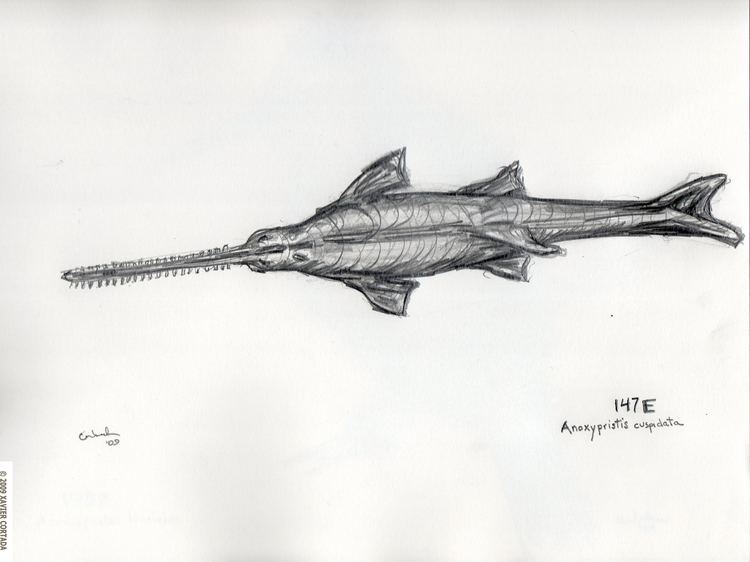Subclass Elasmobranchii Family Pristidae Higher classification Anoxypristis | Phylum Chordata Order Pristiformes Scientific name Anoxypristis cuspidata Rank Species | |
Genus AnoxypristisE. I. White and Moy-Thomas, 1941 Similar Longcomb sawfish, Dwarf sawfish, Largetooth sawfish, Common sawfish, Smalltooth sawfish | ||
Knifetooth sawfish meaning
The knifetooth sawfish (Anoxypristis cuspidata), also known as the pointed sawfish or narrow sawfish, is a species of sawfish in the family Pristidae, part of the Batoidea, a superorder of cartilaginous fish that includes the rays and skates. The sawfishes are characterised by the long, narrow, flattened rostrum or extension on their snout. This is lined with sharp transverse teeth, arranged in a way that resembles the teeth of a saw. It is found in the shallow coastal waters and estuaries of the Indo-West Pacific, ranging from the Red Sea and the Persian Gulf to southern Japan, Papua New Guinea and northern Australia. It is the only member of the genus Anoxypristis, but was previously included in the genus Pristis. Compared to that genus, Anoxypristis has a narrower rostral saw with numerous teeth on the distal part and no teeth on the basal quarter. This endangered species reaches a length of up to 4.7 metres (15 ft).
Contents

Description

The knifetooth sawfish grows to a maximum length of about 4.7 metres (15 ft). Its body is generally shark-like but its most obvious feature is the flattened head which is extended forward in a blade-like bony snout with, in Australian waters, 18 to 22 pairs of sideways-facing teeth, though elsewhere there may be as many as 25. These teeth are short and flat and are roughly triangular in shape. The blade does not taper towards its point and the basal quarter is devoid of teeth. The nostrils are narrow and partially concealed by nasal flaps. The skin of young sawfish is smooth but on older individuals it is sparsely covered in dermal denticles. The dorsal (upper) side of the fish is greyish and the ventral (lower) side a rather paler grey colour and the fins are also pale. The rostrum is grey with white teeth and sometimes has a chocolate-brown base portion.
Distribution and habitat
The knifetooth sawfish is distributed across a broad swathe of the Indo-Pacific Ocean. At its westernmost extreme, it is present in the Gulf of Arabia and may extend as far as Somalia. It is present in the waters off Iran, India, Sri Lanka, Bangladesh, Malaysia, Burma, Indonesia and Papua New Guinea. Its northernmost limit is the Gulf of Chihli, China, South Korea and the most southerly parts of Japan and its southern limit is the northern Australian states of Western Australia, Northern Territory and Queensland. This is a bentho-pelagic fish which is found at depths down to about 40 metres (130 ft). It tolerates low salinity levels and is found in inshore waters including bays and estuaries.
Behaviour

The knifetooth sawfish feeds on small fish, squid and invertebrates such as crabs and shrimps. It uses its rostrum in a side-to-side thrashing action to stir up the sediment and uncover concealed prey and also among schools of fish to incapacitate or stun individual fish. It is itself prey to various sharks such as the hammerhead shark (Sphyrna spp.), the bull shark (Carcharhinus leucas) and the copper shark (Carcharhinus brachyurus) and also the saltwater crocodile (Crocodylus porosus).

The breeding behaviour of the knifetooth sawfish has been little studied. Fertilisation is internal and a number of young develop at one time in the oviduct, each one being nourished from a yolk sac. They are born, probably after a gestational period of about five months, and litter sizes of 6 to 23 young have been recorded. The pups are probably 0.5 to 0.8 metres (1 ft 8 in to 2 ft 7 in) long at birth and their rostral teeth are not fully developed, being covered by a membrane, and this prevents them from damaging the mother's tissues.
Status

Pregnant females and juvenile knifetooth sawfish are particularly susceptible to entrapment in fishing gear and this is the major threat faced by this fish. Overfishing and habitat degradation through urbanisation of the coastline also put this species at risk and the population trend is downward. For these reasons, the IUCN have listed this fish as "Endangered" in its Red List of Threatened Species.
